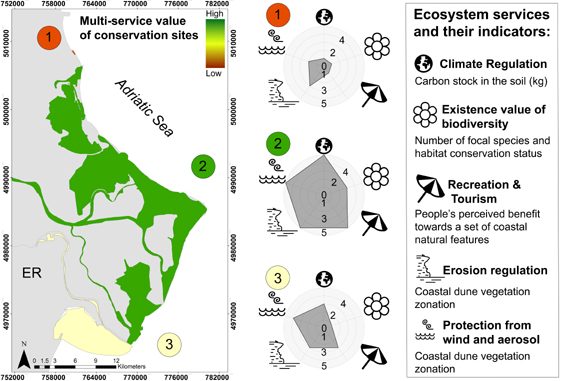
Coastal sand dunes are complex transitional systems hosting high levels of biodiversity and providing important benefits to society. In this paper we aimed to evaluate the multi-service nature of ecosystem services (ES) supply in the dunes of the Italian Adriatic coast within Natura 2000 (N2K) sites. We i) identified ES indicators and assessed the supply capacity (Climate regulation, Protection from wind and aerosol, Erosion regulation, Recreation and Tourism and Existence value of biodiversity) of natural dune ecosystems of European conservation concern; ii) upscaled this data to create an inventory of ES supply for all dune N2K sites in the study area; iii) explored the trade-offs among ES; and iv) summarized and spatially compared the overall multi-service value of the N2K sites.
The study provides a method for quantifying the role of N2K sites in supplying benefits for our society. We found that the multi-service capacity of coastal dunes is uneven within sites and within administrative regions. This variability is related to both ecological (e.g. distribution, ecological integrity, extent and conservation status of dune habitats) and administrative (e.g. local implementation of the Habitats Directive) characteristics of the analysed area. ES are not coupled as several sites with high values for one ES show very low values for others.
The results suggest that conservation actions should favour restoration of the natural dune zonation, since this underpins multi-service ES supply. The approach can distinguish regions with high ES values and regions where the paucity of protected areas represents a gap in ES supply, fact that offers an incentive to enhance the protection strategy but also suggests an urgent need to improve the N2K network by enlarging existent sites and including new ones.
https://doi.org/10.1016/j.scitotenv.2019.02.364

Commenta per primo